PERCUBA
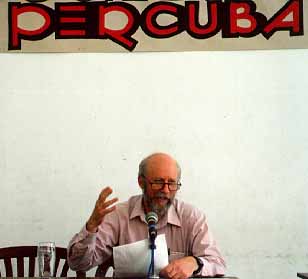 10TH Annual International Percussion Festival
10TH Annual International Percussion Festival
Havana, CUBA April 13-17, 1999
The University of Maine Percussion Ensemble, Dr. Stuart Marrs, Director performed at the 10th annual PERCUBA International Percussion Festival held in Havana, CUBA April 13-17, 1999. In addition, Dr. Marrs presented a scholarly paper on Percussion in Costa Rica from 1972-82, a period during which he was timpanist in the National Symphony Orchestra of Costa Rica and professor at the National University of Costa Rica and the famed Youth Program of the National Symphony Orchestra.
The trip provided an exceptional experience in cultural immersion for the UMaine percussion students, since they spent a week working with and around their Cuban peers. The concert performed by the UMaine group was a smashing success, garnering a 3-minute standing ovation from the standing-room-only crowd at the festival.
The following is a journal of sorts and commentary on the experience by Dr. Stuart Marrs:
The Flight
At first we were not happy with the flight itinerary. Check-in for the charter flight from Miami to Havana was at 3:00am with the flight actually scheduled to take off at 8:00am. That was bad enough, but the closest connection we could get was a flight that arrived at MIA at 9:00pm a six hour layover prior to check-in. As it turned out, we were delayed three hours due to fog at the Newark airport which, granted, only reduced our layover to a 3-hour layover, but the extra cushion for such an important connection was comforting. The charter is not a regular flight in that if you miss it, you can’t just get on the next one. And even if you could, this was Monday and the “next” one would not have been until Saturday: the last day of the festival.
8 lines and 5 hours to check in and board a 45 min flight to Havana. I am sure you have the same questions we all wondered about as we waited for the 3:00am check-in time to roll around: Why does this check-in require so much time? And why at 3:00am? First of all, the charter company, ABC, set up shop right in the main waiting area in front of the United Airlines ticket counter. Out come a couple of folding tables and chairs with assistants to help passengers fill out the two or three forms which haven’t already been filled out ahead of time in the first stages of the process. Then there were a series of 8 lines through which everyone had to suffer: the $50 airport tax line, the luggage-weighing line, the luggage x-ray line, the overweight calculation charge and payment line, just to list a few. The ticket said that we were allowed 44lbs NOT including carry-on, and that is how we prepared the bags, (which included some rather heavy percussion instruments). When we arrived at that line, however, they informed us that 44lbs is the TOTAL weight, including carry-on. So, we ended up having to pay over-weight. Taking into consideration that we were flying in a half-empty Boeing 767, we were not happy about the scam, but under those circumstances, there was nothing to be done about it.
Computer at Cuban customs. My luggage didn’t arrive on the conveyor belt until the very end. One of the workers said that it is probably due to some electrical device that they detected with their x-ray. Sure enough, they wanted to look at my laptop computer (which, by the way, was not harmed by any of the x-rays to which it was subjected). The first Cuban customs agent who looked at it wasn’t sure whether it could come in duty free and called another over, the second thought so, but they decided that a conference was in order and called a third agent who confirmed that the old 386 laptop could indeed enter the country without paying duty. After that half-hour delay, I finally made it out of the warehouse style customs and luggage area to the curbside where I was met by the people who had been sub-contracted by Havanatur to pick us up.
The trip into Havana from the airport gave us our first taste of the famous “living museum” of old cars. There were many pre-1960 vintage American vehicles on the road and running very well. There were, of course, many other non-American models, oodles of motorcycles with sidecars, and quite a few bicycles.
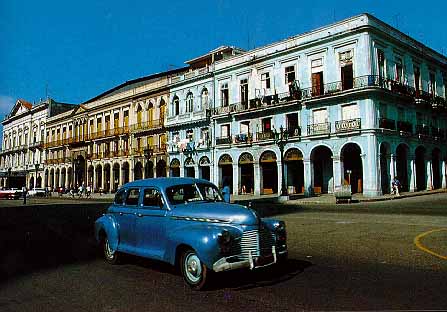 Work. We worked under less than ideal circumstances, as one might expect at a festival with less than an ideal supply of material resources. Nevertheless, the entire administrative team worked very hard to make everything run as smoothly as possible. Further, they all worked with a selfless kindness and warmth that apparently IS in abundant supply in Cuba. Pictured below with me is Lino A. Neira Betancourt, President of PERCUBA and Professor at the Instituto Superior de Arte (at right) and an officer of PERCUBA (center).
Work. We worked under less than ideal circumstances, as one might expect at a festival with less than an ideal supply of material resources. Nevertheless, the entire administrative team worked very hard to make everything run as smoothly as possible. Further, they all worked with a selfless kindness and warmth that apparently IS in abundant supply in Cuba. Pictured below with me is Lino A. Neira Betancourt, President of PERCUBA and Professor at the Instituto Superior de Arte (at right) and an officer of PERCUBA (center).
Our concert required a very large set-up with multiple-percussion parts for each player in one of the pieces. The first task on our first rehearsal on Monday afternoon was to locate and move all of the needed instruments (or substitutes for the ones that they did not have) to the rehearsal room: a job that took over an hour of our designated rehearsal time. There were several factors that further complicated matters. First, 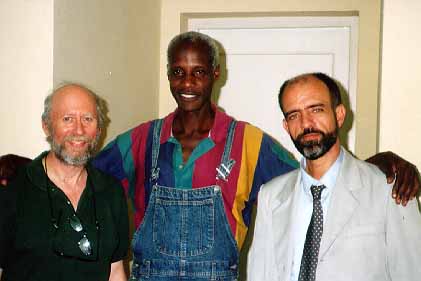 one of our players was an alumnus who joined us in Miami and hence had not rehearsed anything with us. Then, the chorus that was to join us (five or six tenors) could not be present at the rehearsal. Instead, I met with the director of the chorus, who had just received the score that morning, and went over musical details with her. She promised to work with her singers on the part for Wed.’s rehearsal. We finally got most of our instruments set up, only to find that the music stands had not yet arrived… nor had two of the mallet instruments,… nor had several other instruments. We took advantage of the time to make a comprehensive list of everything we needed and which institution would provide for each piece of the puzzle. We did a small amount of playing, but it was pretty much a wash. Another factor in all of this was that April 12 was on of the hottest days on record for ANY time of year in Cuba… and the air-conditioning for the room was broken! The last factor to mention was that, due to the travel itinerary, none of our group had slept for over 30 hours at this point. At one point when I was talking to a Cuban musician, I glanced over to the side of the room to see my five students seated in a row: all with their heads hanging down in seated reverie.
one of our players was an alumnus who joined us in Miami and hence had not rehearsed anything with us. Then, the chorus that was to join us (five or six tenors) could not be present at the rehearsal. Instead, I met with the director of the chorus, who had just received the score that morning, and went over musical details with her. She promised to work with her singers on the part for Wed.’s rehearsal. We finally got most of our instruments set up, only to find that the music stands had not yet arrived… nor had two of the mallet instruments,… nor had several other instruments. We took advantage of the time to make a comprehensive list of everything we needed and which institution would provide for each piece of the puzzle. We did a small amount of playing, but it was pretty much a wash. Another factor in all of this was that April 12 was on of the hottest days on record for ANY time of year in Cuba… and the air-conditioning for the room was broken! The last factor to mention was that, due to the travel itinerary, none of our group had slept for over 30 hours at this point. At one point when I was talking to a Cuban musician, I glanced over to the side of the room to see my five students seated in a row: all with their heads hanging down in seated reverie.
Our next, (which would really be our first rehearsal) was scheduled for Wed. from 7:00-10:00pm which would be immediately following that day’s scheduled events. The last group got started late and had a rather large set-up which set our rehearsal back about an hour and a half. So now it was 8:30 and we were just beginning to move the instruments into the rehearsal hall (another half-hour of work). Finally we got started and had a reasonable rehearsal, except that we didn’t finish until after 11:00pm.
Now, a word about the instruments themselves. The mallet instruments are old and in very bad shape. They are very badly out of tune and some of the posts that suspend the bars are missing, leaving those bars resting directly on the frame of the instrument thereby producing a “clunk” every time you strike that bar. On one of the marimbas, the low C is broken in the middle of the bar so that it buckles up in the middle like a mountain rising as the result of tectonic collision. There is no resonance for either of the marimbas, of which they have two of four-octave range.
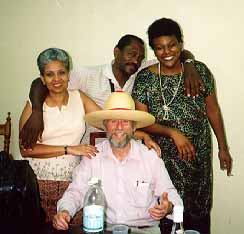 Executive meeting. At the end of our second day (the first day of the festival), I was invited to attend the executive meeting that follows each days activities. The meeting begins with elaborate toasts to the festival and everyone involved. Curiously, the first drop of rum is poured on the floor “for the gods”. The rest, however, is consumed freely and the mood is one of great mirth and celebration. In the meanwhile, some business gets done. At one point, I was honored by one of the executives, who also happens to be Cuba’s leading shekere players, by his crowning me with his hat: an act that surprised everyone since it is only reserved for very rare and special occasions.
Executive meeting. At the end of our second day (the first day of the festival), I was invited to attend the executive meeting that follows each days activities. The meeting begins with elaborate toasts to the festival and everyone involved. Curiously, the first drop of rum is poured on the floor “for the gods”. The rest, however, is consumed freely and the mood is one of great mirth and celebration. In the meanwhile, some business gets done. At one point, I was honored by one of the executives, who also happens to be Cuba’s leading shekere players, by his crowning me with his hat: an act that surprised everyone since it is only reserved for very rare and special occasions.
Food. The price of food was comparable to what you could do in the States. That is, if you chose to eat at the hotel or at a restaurant you could pay prices typical of U.S. moderately priced restaurants. It is possible, however to eat less expensively. My plan at the Copacabana included breakfast which turned out to be a huge buffet. So, I was able to eat a hearty meal at breakfast consisting of an omelet, rice and beans, fruit, coffee, etc., and then just grab what I could the rest of the day and it worked out just fine.
Lunch at Gran Palenque. It is hard to find reasonably priced food on the street. Either it is a very expensive restaurant for tourists or it is food for workers which is not available to non-workers. We did find one nice restaurant with a beautiful patio that wasn’t too expensive and we ate there a few times. It was a nice tropical experience for the guys and brought back many memories of Costa Rica for me. There was an inner courtyard surrounded by palm trees and tropical flora with a bar at one end. A musical group of four serenaded the tourists with typical Cuban songs adding to the atmosphere.
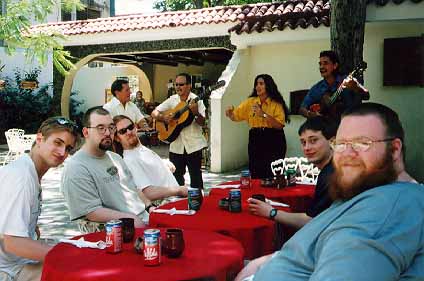 Swimming. The UMaine students managed to spend some time in the water: Their hotel was just a block from the beach. It was not a sand beach, however, so the first time they went in, they cut up their feet on the coral oops! Most of the rest of their swimming was confined to the hotel pool after that. The pool actually served double duty, since they rarely had running water in their rooms. Cuba has programmed shut-downs of the water supply as well as programmed blackouts for saving energy. Coming from Maine, they were impressed with the very warm temperature of the water. Going into the water on the Maine coast at any time of year is a test of courage.
Swimming. The UMaine students managed to spend some time in the water: Their hotel was just a block from the beach. It was not a sand beach, however, so the first time they went in, they cut up their feet on the coral oops! Most of the rest of their swimming was confined to the hotel pool after that. The pool actually served double duty, since they rarely had running water in their rooms. Cuba has programmed shut-downs of the water supply as well as programmed blackouts for saving energy. Coming from Maine, they were impressed with the very warm temperature of the water. Going into the water on the Maine coast at any time of year is a test of courage.
Mexican group from Monterrey. The percussion ensemble from the Escuela Superior de Música y Danza de Monterrey has attended the festival before. Its director, Noel Savón Favier, conducted a concert with a group of very enthusiastic and talented young Mexican percussionists. After the UMaine performance, Noel approached me to see if I would be interested in visiting his school as a guest artist and professor. Hester Martínez Nardea, the artistic director of a dance ensemble called “Hybrido,” also from Monterrey is interested in choreographing “Uneven Souls” (the work in which I performed as marimba soloist at PERCUBA) for her group and having me come down for a dance production. I hope it works out.
Extremely attentive hosts. I was impressed with the warmth and unbounded hospitality of our hosts. I use the term “hosts” in its broader sense: the Cubans. In spite of economic hardships, they maintain a positive attitude and work with smiles on their faces. I have already alluded to the graciousness and good humor of the PERCUBA staff, but this attitude even extended to the driver of the mini-bus that schlepped us back and forth to the hotel. When we had a rehearsal that went over an hour later than scheduled, taking us to 11:30pm before we finished, the driver waited patiently and expressly told us not to worry he was enjoying listening to the rehearsal.
Luis Barrera. I spent quite a bit of time with Luís Barrera, timpanist with the National Symphony Orchestra of Cuba. He is an interesting and enthusiastic musician. He was constantly pumping me for feedback and ideas percussionistic. At one point we were discussing cymbal playing technique and I described a technique that I saw Neil Grover demonstrate at a clinic kind of a variation on the Philadelphia style (for the cymbal cognoscenti amongst you). We didn’t even have a pair of cymbals for demonstration during the discussion, but the next day, Luís saw me and said that they had tried it in the symphony and they were already implementing the technique.
Cigars from driver. Since U.S. customs allows travelers who are returning directly from Cuba to bring back a small quantity for personal use, everybody in Havana wants to sell you cigars. Just waking down the street, someone will yell out of a car window, hawking cigars to the vulnerable foreigner. The first one to approach us was the driver of the mini-van. $45 for a box of Cohiba Esplendidos seemed like a great deal, (in the hotel, they went for $350), and I figured that he would not rip us off since he was going to have to be our driver for the rest of the week. I showed the box to a PERCUBA official and he said that he could not be sure that the box was authentic, since some of the seals on the box were not placed exactly as they should have been. Apparently, there is a danger that some scoundrels will make cigars out of banana leaves and pawn them off as Cohibas. Everyone’s line is that they have a brother-in-law who works in the factory or some such situation, which allows them to get the product for virtually nothing and pass the savings along to the buyer. The PERCUBA official said that HE could get me the real thing for $40 because he has a friend that works in a hotel. Anyway, I was able to return the ones from the driver, (he didn’t protest too much), and bought a box from the official. After showing you the cigars and allowing you to test them, he then “seals” the box himself in front of your eyes (as if I could tell the difference between real ones and fakes!) According to my friends who know about these things, I did indeed come home with the real thing.
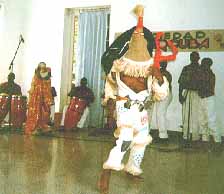 Community folkloric group from Matanzas: santeros. One of the most intense and impressive presentations of the entire week was by “Iré-Aché” a community group from Cardenes in the province of Matanzas. They put on a demonstration of music, dance, theater and song typical of their province focusing on the Afro-Cuban styles and ceremonies of Abacuá, Arará, la Regla de Ochá, and the rumba cycle. Some of the presentations were pure dance with song and music. The drum beats were hot and complex with the quinto (high conga drum) closely following the dancer’s every move by improvising fast and soloistic patterns so as to truly form a duet of dance and drum. Other presentations were more theatrical. One told the story through dance, of a rebellious slave who is eventually shot to death by the overseer. He is then brought back to life by a “santero” priest. During the pieces, the rum flowed freely as part of the show. Mostly for ceremonial purposes, it was poured on the floor as a “libation” or offering to the gods. But it was also offered to members of the audience and used in some of their fire “tricks” e.g. blowing rum stored in the mouth through a flame, producing a burst of fire. There were many other stunts such as fire-eating, quasi self mutilation with machetes and torches. One man let an audience member hold a burning torch under his face and under his forearm without any visible effect of burning. He then proceeded to hold the lit torch inside and down the front of his pants! All throughout these presentations the dancers were very intense. The looks on their faces were almost frightening and I was not alone in thinking twice before making eye contact. One had the feeling that something strange, at best, would happen.
Community folkloric group from Matanzas: santeros. One of the most intense and impressive presentations of the entire week was by “Iré-Aché” a community group from Cardenes in the province of Matanzas. They put on a demonstration of music, dance, theater and song typical of their province focusing on the Afro-Cuban styles and ceremonies of Abacuá, Arará, la Regla de Ochá, and the rumba cycle. Some of the presentations were pure dance with song and music. The drum beats were hot and complex with the quinto (high conga drum) closely following the dancer’s every move by improvising fast and soloistic patterns so as to truly form a duet of dance and drum. Other presentations were more theatrical. One told the story through dance, of a rebellious slave who is eventually shot to death by the overseer. He is then brought back to life by a “santero” priest. During the pieces, the rum flowed freely as part of the show. Mostly for ceremonial purposes, it was poured on the floor as a “libation” or offering to the gods. But it was also offered to members of the audience and used in some of their fire “tricks” e.g. blowing rum stored in the mouth through a flame, producing a burst of fire. There were many other stunts such as fire-eating, quasi self mutilation with machetes and torches. One man let an audience member hold a burning torch under his face and under his forearm without any visible effect of burning. He then proceeded to hold the lit torch inside and down the front of his pants! All throughout these presentations the dancers were very intense. The looks on their faces were almost frightening and I was not alone in thinking twice before making eye contact. One had the feeling that something strange, at best, would happen.
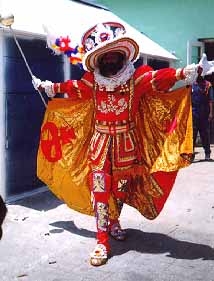 The Bahamians As an international festival, there were groups from several other countries, but the most colorful were the Bahamians. They brought a full “Junkanoo” band led by none other than the internationally famous, John “Peanuts” Taylor. He gave a wonderful musicological paper on the origins and development of Junkanoo in the Bahamas, followed by a typical celebratory parade.
The Bahamians As an international festival, there were groups from several other countries, but the most colorful were the Bahamians. They brought a full “Junkanoo” band led by none other than the internationally famous, John “Peanuts” Taylor. He gave a wonderful musicological paper on the origins and development of Junkanoo in the Bahamas, followed by a typical celebratory parade.
Musical Life in Latin America I have been asked to write the article on Musical Life in Cuba for the Greenwood Press publication, Musical Life in Latin America. I had written articles about Bolivia, the Dominican Republic and several composers for a companion volume titled, “Composers of Latin America” and the editor asked me to take advantage of the trip for some field work to write the Cuba article. I met with two Cuban musicologists who agreed to help me with the general article and with some of the composers. Since they teach at the Instituto Superior de Arte, they have access to research papers and dissertations written by Cuban students about each one of the composers which will doubtless be of great help to me.
UMaine Percussion Ensemble Concert Our concert on Friday went very well. We had programmed four pieces: The Quinteto para Marimbas by Costa Rican composer Marvin Araya; the Concerto for Marimba and Percussion Ensemble by Brazilian composer and percussionist Ney Rosauro; the Barber Adagio for Strings which we were playing on the xylophonic mallet instruments available at PERCUBA and Uneven Souls by Nebojsa Jovan Zivkovic. The Araya was great as an opener. We knew it would be because of its Cuban/Latin content. The Rosauro concerto is a great piece and they know Ney from his participation in a previous PERCUBA. Our soloist, UMaine junior Bryan Cook did a fabulous job and by this time the standing-room-only crowd was really jumping. At that point, Chris Andrews, a UMaine alumnus who broke away from grad school at the University of Minnesota to join us for this trip, suggested that perhaps we should skip the Barber. Here was the reasoning: a) the instruments that we had at our disposal (two xylorimbas of 4 octaves each and two marimbas of 4 octaves each all had broken bars and were wicked out of tune; b) the audience had reached a heightened state of excitement and the Barber is slow and meditative; and c) we would be taking a risk performing it without a conductor (I had to play, because not all of our ensemble members could make the trip). I decided in those couple of seconds of consideration that we had better not play it. So we went directly to the Zivkovic. It was a great hit, (as it always is) and we received a 3-minute standing ovation from the appreciative audience.
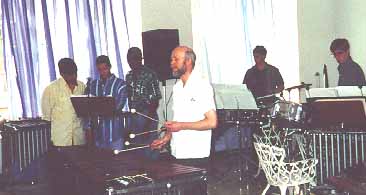 The Cuban “School” of percussion is very strong. Tuesday was dedicated to youth and percussion education. All of the performers from all three levels, elementary, intermediate, and advanced were fabulous. They played with excellent technique accompanied by a refreshing relaxed musicality. All of the students learn total percussion i.e. not just drums or mallets or congas. Further, no matter where they study on the island, they all learn the same technique. So a student who lives in Guantanamo studies the same technique as the student from Havana. It is a good thing that they are learning good stuff! I asked one of the teachers what she did with students who were slow or lazy, in response to which she merely gave me a quizzical look, not comprehending the question. It turns out that the students for this track of specialization are selected at a young age and they all succeed. The reasoning goes like this: The state has very limited resources and to most efficiently invest those limited resources, they select at a very young age, those that will continue (on the State’s tab) in any given area of specialization e.g. sports, music, engineering etc. It works for them. The State also encourages and supports amateur activities like community ensembles and folkloric groups, so no one is excluded from any activity. It is just that the State cannot afford to foot the bill for anyone to try anything that one wants. There was another manifestation of this at Friday night’s cabaret presentation. We were treated to a cabaret show put on by the Cuban school for cabaret spectacles. Like a conservatory, the students study music and dance but of a popular nature. There are also studies in circus acts like juggling etc. It was impossible not to notice that all of the women were physically beautiful. I was told that the students for this school are selected in part on physical appearance.
The Cuban “School” of percussion is very strong. Tuesday was dedicated to youth and percussion education. All of the performers from all three levels, elementary, intermediate, and advanced were fabulous. They played with excellent technique accompanied by a refreshing relaxed musicality. All of the students learn total percussion i.e. not just drums or mallets or congas. Further, no matter where they study on the island, they all learn the same technique. So a student who lives in Guantanamo studies the same technique as the student from Havana. It is a good thing that they are learning good stuff! I asked one of the teachers what she did with students who were slow or lazy, in response to which she merely gave me a quizzical look, not comprehending the question. It turns out that the students for this track of specialization are selected at a young age and they all succeed. The reasoning goes like this: The state has very limited resources and to most efficiently invest those limited resources, they select at a very young age, those that will continue (on the State’s tab) in any given area of specialization e.g. sports, music, engineering etc. It works for them. The State also encourages and supports amateur activities like community ensembles and folkloric groups, so no one is excluded from any activity. It is just that the State cannot afford to foot the bill for anyone to try anything that one wants. There was another manifestation of this at Friday night’s cabaret presentation. We were treated to a cabaret show put on by the Cuban school for cabaret spectacles. Like a conservatory, the students study music and dance but of a popular nature. There are also studies in circus acts like juggling etc. It was impossible not to notice that all of the women were physically beautiful. I was told that the students for this school are selected in part on physical appearance.
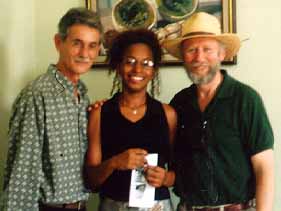 Invited to preside over graduation committee. I was asked if I would be willing to chair a graduation evaluation committee for one of the students performing a recital at PERCUBA. It truly was an honor. The student was graduating from intermediate level to advanced level. She was around 19 years old. Without hesitation, I would say she could easily be placed at a junior standing level of most U.S. university music schools. Or put another way, they are around a year ahead of the average U.S. percussion student. As president of the evaluation committee, I had the honor of signing the official document authorizing her graduation.
Invited to preside over graduation committee. I was asked if I would be willing to chair a graduation evaluation committee for one of the students performing a recital at PERCUBA. It truly was an honor. The student was graduating from intermediate level to advanced level. She was around 19 years old. Without hesitation, I would say she could easily be placed at a junior standing level of most U.S. university music schools. Or put another way, they are around a year ahead of the average U.S. percussion student. As president of the evaluation committee, I had the honor of signing the official document authorizing her graduation.
Cuban student to Costa Rica to study musical influences. A Cuban student who came to my paper presentation came up to me afterwards and asked if I could help her make some contacts in Costa Rica. It turns out that she wants to go there to do some musicological studies on Cuban influences in the music of other Caribbean nations. I was happy to help her by giving her some names of people who I know would be of help to her. An interesting aside to this interaction took place as we were walking down a hall in the Casa de la Cultura. We were walking behind an administrator for PERCUBA and I began to discuss her project as we walked. Immediately, she put her finger up to her lips to shush me. As an explanation, she later gave me some Spanish aphorism which was the academic project equivalent to “Loose lips sink ships.”
Invitation to Santeria ceremony. I was talking informally to a PERCUBA attendee about Santería, and he said that in Havana, the ceremonies are “open door” and anyone was welcome to attend. He further added that he could take me to one if I so desired. I replied that it would be great, but that all of my remaining time in Cuba had already been booked. Later on I was once again admonished by my hosts to only coordinate this type of thing through them so that they could be assured that everything was on the up-and-up.
Lessons with Cuban percussionists. Several of my students arranged to take lessons with local Latin percussionists. After all, this is the “source.” From Afro-Cuban musicians residing in New York sprang the musical genre that we today call “salsa.” Says Darryl Blease, one of the students who sought out lessons, “What impressed me the most was our ability to communicate with a very limited knowledge of Spanish and our teacher’s inability to speak English.” The lessons were reportedly very good, the only drawback being the persistent requests from the teacher offering more lessons. These lessons, very inexpensive by American standards represented a huge windfall for the Cuban percussionist and he didn’t want them to stop.
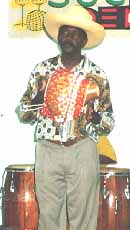 Concert of masters at last day of festival. The final presentation of the last day of the festival was a concert by Pancho Terry and friends. This in itself was amazing how a simple shekere could be used with such effectiveness as a lead instrument. But then followed a “descarga,” a Cuban percussion jam session, with all of the greats in attendance joining in. Nirvana for a Latin percussionist.
Concert of masters at last day of festival. The final presentation of the last day of the festival was a concert by Pancho Terry and friends. This in itself was amazing how a simple shekere could be used with such effectiveness as a lead instrument. But then followed a “descarga,” a Cuban percussion jam session, with all of the greats in attendance joining in. Nirvana for a Latin percussionist.
Inexpensive Latin percussion instruments. There were lots of good inexpensive Latin percussion instruments for sale at PERCUBA and from individuals attending the conference. The stories about people trying to sell instruments were similar to the cigar stories. So you can get great deals there, but you have to worry about shipping and U.S. customs. My students who brought stuff back had no problem at customs. Others have had problems with maracas, for example, because of the seeds. It is impossible to predict for sure how instruments with natural parts like hide heads, will be treated in customs. The most impressive instruments at the festival were unfortunately not for sale.
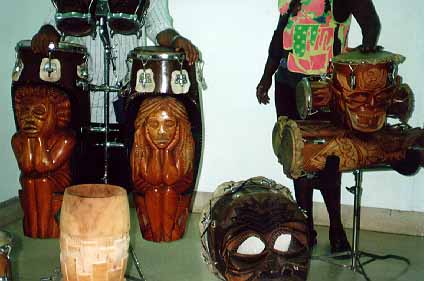 Coctail Saturday night at the Villa Elaria
Coctail Saturday night at the Villa Elaria
It began with the ubiquitous power outage, until after an hour or so of waiting around on the ample garden-surrounded porch the lights came back on and we were let in to the old and venerable bed and breakfast. We were all seated at round vinyl deck tables on a covered patio. There were approximately 20 tables and the place was packed. We had joined two tables so that all of the executives from PERCUBA (except Lino, who was at another table) could sit together. Our tables were off to one side and rather difficult to get to. One of the actors/dancers who was to perform that evening, was dressed as Eleggua – the orisha who the opens the doors to the rest of the ceremony. He was making the rounds, blessing everyone seated at the patio. Since we were so far off to one side, however, he missed our tables. About 15 min later they began bringing rum, cola, and glasses to each table. Another quarter hour passed and it seemed that everyone else was busy imbibing the national drink while we were left sitting there. Someone at the table noted that we had not yet been served and I uttered the phrase of the evening pointing out that, “Ni Eleggua ha pasado por esta mesa!” (“Not even Eleggua has passed by our table yet!”) at which time they all cracked up. Eleggua was alerted to his oversight and he came right over to bless us all. Immediately after that, the rum arrived. Even before the official show began, the Bahamians had broken out their instruments and were playing and dancing. The show consisted of a batá and percussion group who accompanied dancers and singers who went through a cycle of salutes to different orishas. Each dancer was dressed in the attire appropriate to their respective orisha: ogun, shango, etc. and the beat of the batá was also coordinated with the performance of each orisha. All of the Cubans knew the lyrics in Yoruba to the salutes and would often sing along in the response section. It was impossible for anyone to sit still during this exciting music of heightened rhythmic activity. The show concluded with all getting up en mass to dance to a long litany of a coda to the production. There was a short refrain that was repeated over and over while people would raise their hands into the air all at the same time: an act that seemed to have some significance that escaped me. Nevertheless, I was brought onto the dance floor with all the others by one of the dancer/orishas and joined in as best as I was able. We had a wonderful evening that ended for me around 1:30am.
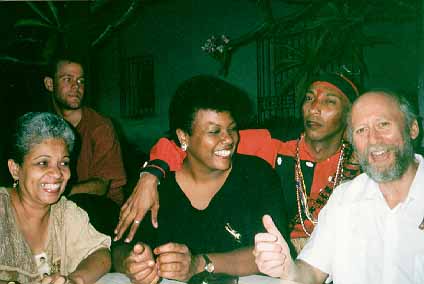 Finally, Sunday, a day to go to the beach. For the previous three days, I had been negotiating with our driver trying to strike an acceptable deal to take us to Varadero, the number one tourist and beach town about 120km from Havana. When it came to the moment of truth, my students balked and decided that they would rather go to a nearby sandy beach, Santa Maria. They were not interested in the tourist scene and they would have to get up very early in order to return in time for the Havana Philharmonic concert at 5:00pm that afternoon.. Once again, my students steered me in the right direction. Sunday’s weather proved to be cold, windy, and drizzly. Had we paid the driver for the long trip to Varadero ahead of time as he was asking, we never would have been able to cancel due to the weather and we would have had a miserable time. As it was, we walked around down town and got a good feel for residential Havana, ending up at the concert hall, the newly renovated Teatro Amadeo Roldán.
Finally, Sunday, a day to go to the beach. For the previous three days, I had been negotiating with our driver trying to strike an acceptable deal to take us to Varadero, the number one tourist and beach town about 120km from Havana. When it came to the moment of truth, my students balked and decided that they would rather go to a nearby sandy beach, Santa Maria. They were not interested in the tourist scene and they would have to get up very early in order to return in time for the Havana Philharmonic concert at 5:00pm that afternoon.. Once again, my students steered me in the right direction. Sunday’s weather proved to be cold, windy, and drizzly. Had we paid the driver for the long trip to Varadero ahead of time as he was asking, we never would have been able to cancel due to the weather and we would have had a miserable time. As it was, we walked around down town and got a good feel for residential Havana, ending up at the concert hall, the newly renovated Teatro Amadeo Roldán.
Symphony Concert. The highlight of Sunday, the last day of our stay in Cuba was a concert by the Havana Philharmonic Orchestra in the beautiful newly renovated Teatro Amadeo Roldán. This was only the second concert given in the new hall and was by invitation only. Fidel had enjoyed the inaugural concert so much that he requested that the concert be repeated not just for the same concert-going crowd, but for people who do not normally attend. Since the audience was made up of people unfamiliar with symphonic music, a musicologist was on hand to provide an introduction to each piece the orchestra played. Well, the start of the concert was delayed due to another power outage, but that was a small inconvenience when viewed in the context of the wonderful concert to follow. We thoroughly enjoyed the very fine music, (most of which was by Cuban composers like internationally known Leo Brouer) and the very professional playing by all sections, (including the percussion section which was using the new cymbal technique that I had explained to Luís Barrera only days before). The acoustics of the small theater were magnificent. A small detail, but nonetheless impressive, was the air conditioning system which had vents in the tops of the seatbacks. At least it was the first time that I had seen such a system. Perhaps because it was so diffuse, it was very quiet, in fact, inaudible.
Final thoughts. Darryl Blease, writing for the group sums it up very well: “Over all, the trip was very well worth it. The level of musicianship in Cuba is inspiring. The culture was eye opening. The salsa clubs were open until very early in the morning. The bands there, consisting of up to fifteen people, kept us entertained with the popular style of Cuban music for the weekend nights just prior our return to the States.
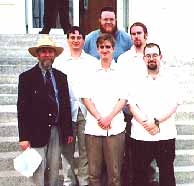 “Our return home marked the end of a very impressive and healthy dose of Cuban music and culture. We returned with many stories and memories that will be with us forever. Our entire group gained invaluable insight into the music and culture of Cuba that we will be able to apply to our own music and playing and use as teaching tools. One of the many educational benefits of the trip is that, there is so much to be gained from the immersion in other cultures than can not be learned simply through textbooks and videos. The first hand knowledge that we experienced in Cuba is priceless and was a great addition to our experience at the University of Maine.”
“Our return home marked the end of a very impressive and healthy dose of Cuban music and culture. We returned with many stories and memories that will be with us forever. Our entire group gained invaluable insight into the music and culture of Cuba that we will be able to apply to our own music and playing and use as teaching tools. One of the many educational benefits of the trip is that, there is so much to be gained from the immersion in other cultures than can not be learned simply through textbooks and videos. The first hand knowledge that we experienced in Cuba is priceless and was a great addition to our experience at the University of Maine.”
